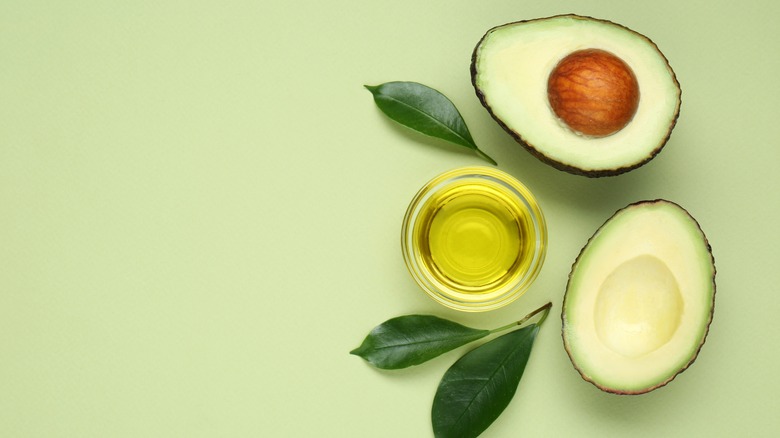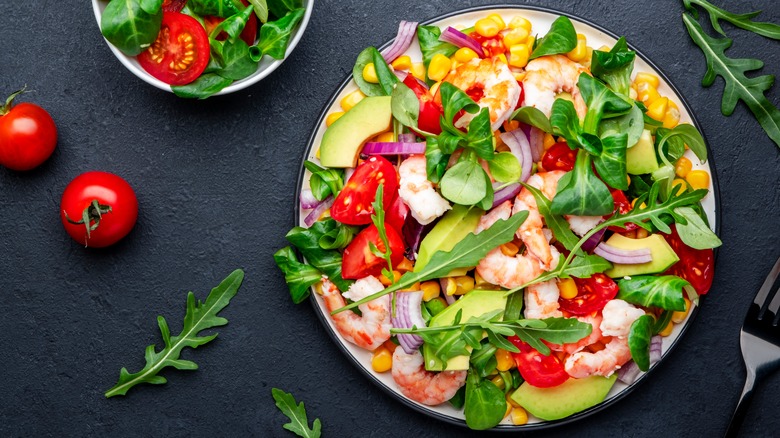The Biggest Red Flag To Look For When Buying Avocado Oil
Avocado oil is an increasingly popular cooking staple due to its high smoke point and relatively neutral taste. However, you may not actually get what you pay for when you grab a bottle from the shelf. According to a 2023 study published in Food Control, only three out of 29 private label samples of avocado oil met both quality and purity standards. In other words, nearly 70% of the oils tested were rancid or diluted with other types of oil.
The shocking gap between the claims on label and the stuff in the container can make it harder to feel confident in the store. For now, the product remains unregulated, so producers generally set and uphold their own standards. That means shoppers have to use their senses and conduct some sleuthing to find a go-to brand.
One of the biggest clues that a liquid isn't what it claims to be is its color. Virgin avocado oil should be a bright and lively green, in keeping with the green-hued fruit's flesh. Refined versions of the oil will look lighter in color, anywhere from pale yellow to clear, indicating it has undergone processing. So for more flavor and freshness, opt for the bold color.
Other clues to understanding avocado oil
Similar to olive oil, the highest quality bottles of avocado oil will have a few familiar words on the label. Look for "virgin" or "extra virgin" designations, as well as "cold pressed," to indicate the avocado oil is going to have more flavor and color. Refined oils will not (or should not) have these designations on the bottle, as they come into contact with heat and other treatments during production that alter their consistency. Although higher price doesn't guarantee the best oil, researchers did find that lower priced bottles were more likely to have cheaper oils mixed in.
Once you get home from the store and open the bottle, also take note of the smell. Rancid oils will smell unpleasant or stale. If you're turned off by the scent or get a whiff of play dough or crayons, likely the product has gone bad. If it has a mild, mushroom-like, or even bitter smell, your batch is probably in good shape. Just be sure to keep sniff testing as it ages in your pantry.
As with other cooking fats, the liquid is vulnerable to oxidation. Keep an eye on the color and any changes in texture as you cook, as this can be a clue the oil is reaching the end of its prime. Store it in a cool, dark place along with other ingredients to extend its shelf-life, which should be about six months.
When to use avocado oil
Avocado oil's ability to handle high temps has earned it a reputation as one of the best high-heat oils to use for a perfect sauté. Refined avocado oil has a smoke point of over 500 degrees Fahrenheit, a staggeringly high figure that's close to 100 degrees higher than olive oil. However, this number drops when using the extra virgin stuff, so keep this in mind when using the green fat, as it can still handle the heat but may eventually hit its limit out on the grill.
That's not all it's good for, however. Pastry lovers can switch to avocado oil for baking, as it can bring welcome moisture and fat into cakes. The cold pressed oil has notes of buttery, nutty sweetness and a slight herbaceous grassiness, similar to the fruit itself. Considering how well avocado pairs with citrus, herbs, and even chocolate, we would imagine it makes for an intriguing taste when swapped into olive oil cakes and drizzled on top of sweet treats like ice cream.
The mild flavor of the green liquid also makes it ideal for salad dressings. This allows its tasting notes to shine and shows off the freshness of your purchase. Anywhere an avocado would shine, the silky oil would do the same.



